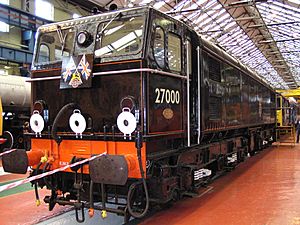British Rail Class 77 facts for kids
Quick facts for kids British Rail Class 77 |
|
 |
|
| Preserved locomotive, no. 27000 in original black livery. | |
| Power type | Electric |
|---|---|
| Builder | BR Gorton Works |
| Build date | 1953–1954 |
| Total production | 7 |
| Configuration | Co+Co |
| Gauge | 4 ft 8 1⁄2 in (1,435 mm) |
| Wheel diameter | 4 ft 2 in (1.270 m) |
| Length | 59 ft 0 in (17.98 m) |
| Locomotive weight | 102.5 long tons (104.1 t) |
| Electric system(s) | 1500 V DC |
| Current collection method | Pantograph, 2 off |
| Traction motors | Metropolitan Vickers |
| Top speed | 90 mph (145 km/h) |
| Power output | 2,490 hp (1,857 kW) |
| Tractive effort | 45,000 lbf (200 kN) |
| Train heating | Steam generator |
| Locomotive brakes | Air and electrical regenerative |
| Locomotive brakeforce | 85 long tons-force (847 kN) |
| Train brakes | Vacuum |
| Career | British Railways |
| Number | 27000–27006 |
| Retired | September 1968 |
| Disposition | All sold to Netherlands as NS 1500 Class |
The British Rail Class 77, also known as Class EM2, was a special type of electric locomotive. These powerful engines were built in the 1950s to pull trains on a challenging railway line called the Woodhead Line. This line connected the big cities of Manchester and Sheffield in England.
Contents
Meet the Class 77 Locomotives
Imagine a time when trains needed a lot of power to climb steep hills! The Class 77 locomotives were designed for just that. They were built by a company called Metropolitan-Vickers between 1953 and 1954. Only seven of these unique engines were ever made.
Power and Design
These locomotives were "electric," meaning they got their power from overhead wires. They used 1500 V DC electricity. This was collected by special arms on the roof called pantographs.
The Class 77s were very strong. They could produce about 2,490 horsepower. This allowed them to pull heavy passenger and freight trains. Their top speed was around 90 miles per hour (145 km/h).
Life on the Woodhead Line
The main job for these locomotives was to work on the Woodhead Line. This railway line was famous for its long tunnels and steep hills. The Class 77s were perfect for this tough job. They helped move people and goods between Manchester and Sheffield for many years.
End of an Era
By September 1968, the Class 77 locomotives were no longer needed in Britain. All seven of them were sold to the Netherlands. There, they were given a new life and became known as the NS 1500 Class. They continued to serve in the Netherlands for many more years.
Images for kids
-
A Class 77 hauled passenger train waiting at Manchester Piccadilly in 1967



